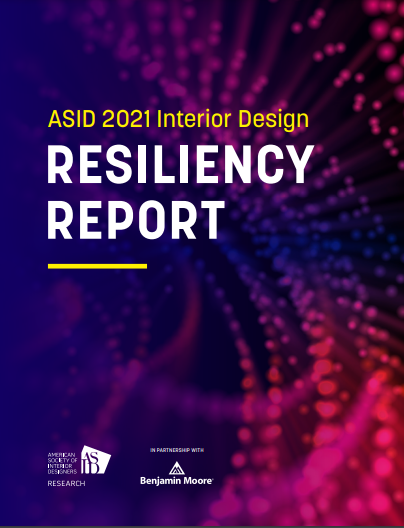ASID sees strong recovery in the design industry in the second installment of resiliency report


As the world continues to feel the impact of COVID-19, the American Society of Interior Designers has been monitoring the resiliency of interior design during these times of disruption. The just-released 2021 ASID Interior Design Resiliency Report represents part two of a multi-phase research study conducted with Benjamin Moore, that began in 2020. The 2021 edition further investigates the pandemic’s impact, as well as the design profession’s experience, response, and recovery, and identifies new ideas to push the industry and profession beyond a state of recovery and into a state of flourishing.
“The continued impact of the pandemic on the interior design industry and on our professional and personal life is undeniable,” explains ASID Vice President, Research and Knowledge, Susan Chung, Ph.D. “As we carry on and learn how to navigate through adjustments and change, we hope that designers can use the Resiliency Report and apply it to their practices and that it will provide them with the knowledge and skills that can better serve our ever-changing environment.”
At the beginning of the pandemic, ASID saw the importance of tracking the strength, significance, and resiliency of interior design during major disruption and designed a multi-year research study. The first phase of the study in 2020 focused on agility and adaptability in the face of disruption, while this second phase in 2021 examined the industry and the profession’s strength during recovery. The 2021 Resiliency Report tracks interior design performance in adversity and reports on best practices for continued and improved resilience, with special concentration on how the interior design community has pivoted to address changes and how design has evolved and innovated during this disruptive period.
When surveying designers and other industry respondents, the study centered on the progress of the industry, explorations of change, how to see beyond recovery and thrive, and the best practices and lessons learned during COVID-19. Key findings include:
Progress
We found stability amid continued disruptions. Although uncertainties remain, we have endured through the initial shock from the novel virus and are applying lessons learned. Average impact ratings were significantly lower in 2021 compared to 2020: impact on interior design business/industry decreased 20%, firm 23%, and life in general 24%.
We continue to struggle with burnout. Our experience with burnout remained unchanged, with 71% of survey respondents indicating that they experienced burnout to some frequency over the past year. Burnout was more prevalent among those that indicated increased work hours, lower personal resilience scores, and lower physical, mental, and social well-being ratings.
We recognize that virtual is here to stay. Continuing education online and virtual conferences made an imprint on our professional lives. The pandemic allowed the progression to experiment with more technology and remote systems in our projects and opened our eyes to new ways of work.
We accept the diversification and broadening of space. Design changes seen in the past year at home, in the outdoors, and beyond have been accepted as part of everyday life. For example, more defined office space at home was experienced by 68% in 2021, and of those, 90% see this to be permanent. With the increased amount of time spent at home, our homes have become a hub for a multitude of activities over a longer period of time and more permanently.
Explorations
We embraced changes and these changes seem to be in flux. The major adjustments in our work processes have mostly been shifts to fare through the pandemic temporarily. Changes related to in-person vs virtual activity (e.g., client meetings, showroom/store visits, and site visits) were experienced by many but projected to be temporary.
We see more changes needed. Although the perception of interior design has been positive throughout the pandemic, 70% of the interior design community still saw that changes in interior design is necessary for the profession to advance.
Beyond recovery to thriving
We should think ahead about the changed experience and its implications. We each experienced the pandemic differently yet have all been impacted by the disruption. This disruption caused multiple activities to collide into one space, whether it be at home or the virtual realm. The once diverse experiences we had as we moved through several places have condensed without much movement.
We need to revisit design integrity and expand design equity. Social media promotes interior design transformations as quick fixes to the public but does not depict reality. We have the responsibility to offer healthy, safe, and quality design to clients, to stand behind the evident-based design solutions, and to ensure the designed projects are what is experienced at the end.
We should move beyond sustainability and into regenerative solutions. The pandemic has augmented issues and conversations in climate change, but sustainability applies to more than the environment. As we rely on our resiliency to get through the pandemic, we hope we will spring forward to not just recover from the damage done but also revive to bring about more positive ways to renew life.
Best practices and lesson learned
Exemplary practices emerged during disruption. This included redesigning existing programs to accommodate rising needs, creating support groups to foster engagement and deeper connections virtually, and investing in rebuilding culture to reflect changes and renew values. In-depth interviews with firms collectively shared lessons on transitions, touchpoints, transparency, talent, and trust as they adjusted and pivoted through the pandemic.
To download a copy of the complete report, visit:
https://www.asid.org/resources/resources/access/311
To view more resources and CEUs, visit our Interior Design Resiliency Hub on the ASID Academy. Be on the lookout for new education content coming in December and January.
